Top 10 Best Animation Software in 2025
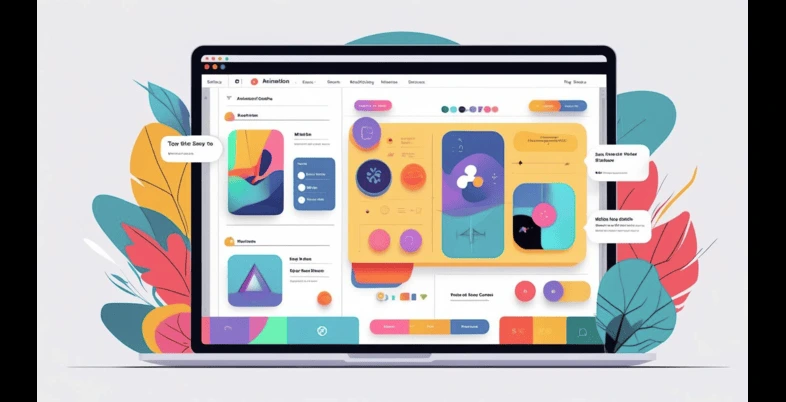
It is as though you just came up with an awesome idea, say, a funny short film, a colorful advertisement, or an instructional video. You can imagine it with your eyes: colorful figures, flowing motion, rich feeling. And actually? All you have is a white screen, and you are imagining in your head. This is where animation software comes into play – your creative suite that enables you to bring thoughts into life as amazing visual images. Be it a student playing with stick figures, a YouTuber providing motion graphics, or a professional animator in major studios, the proper software may help one a lot.
Animation is not a secret place that has been nailed in Hollywood studios or costly production houses. It is possible that in the year 2025, anyone can animate with the right software, and occasionally, the boundary is how far you can be creative.
This Blog will help us discuss the Best Animation Software concerning various requirements, budgets, and capabilities.
What is Animation Software?
Animation software is a computer program that helps you to make moving pictures, or in other words, it is used in cartoons, movies, or even video games. Think of it as a computerized flip book; you just draw or model characters, objects, sceneries, and the computer lets them be animated. You are able to apply effects, sound, and even 3D to lend reality to your ideas.
Artists, filmmakers, game designers, and even laypersons who want to create fun animations use it.
The Importance of Selecting the Right Animation Software
It is important to select the appropriate animation software as it will directly affect the quality of the work conducted, your learning arc, and what you can create.
The appropriate tool can:
- Pick your level of ability– Novices should have simple, intuitive interfaces that are easy to operate, whereas more advanced professionals require a complex interface or advanced features.
- Be more efficient and save time and effort- Good software automates the use of shortcuts, templates, and workflows.
- Match your budget- Some tools are free or not expensive, and some have high licensing fees.
- Write an argument to go with your style– Don’t be afraid to use different software, depending on your style. 2D, 3D, motion graphics, or stop motion tools are all different and do well at different things.
- Make sure it is compatible; it must play well with other tools you use and export in formats that are needed by your audience or clients.
Imagine you were choosing the camera to take pictures; you have the wrong one and you are so restricted, but the right one and your thoughts come to life.
List of Best Animation Software in 2025
Some of the best animation software programs that are available in the market are shown below, and they possess unique strengths.
1. Adobe Animate – Best for Professional 2D Animations
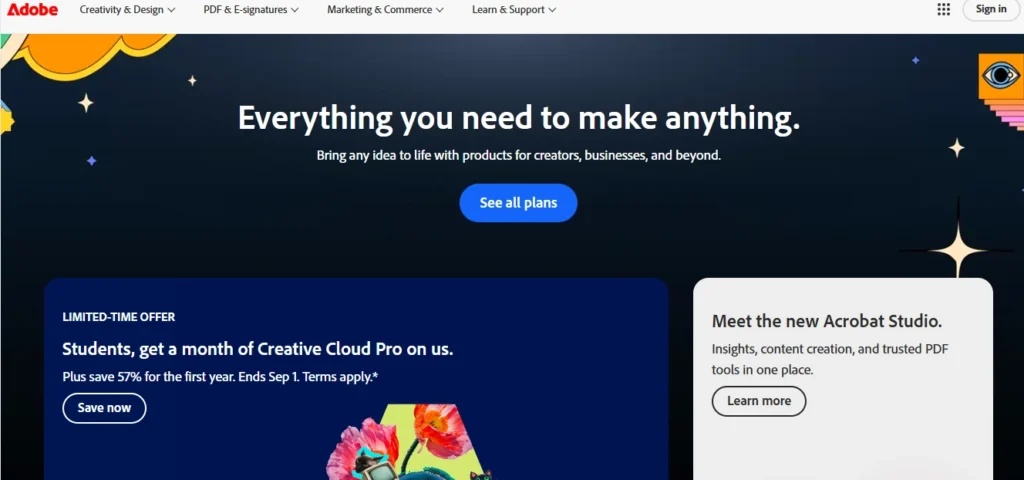
Website: https://www.adobe.com
Whether you desire your 2D animation to appear like it has just come out of a top-notch studio, Adobe Animate is your artistic heavyweight, Precise flexibility. This software is a favorite with the industry and provides the tools to create everything from TV-quality cartoons to web interactive animations. It is difficult to give an accurate explanation of how simple its vector-based design is that someone can create sharp, scalable graphics, ones that can remain flawless regardless of its screen size, whether bigger or smaller.
This friendly design of animation is contributed to by the timeline and the motion-tweening scheme, and it is closely connected with other applications in the Adobe universe (Photoshop and Illustrator), enabling a user to shift the assets effectively through the platform.
YouTube, ads, games, e-learning, whatever you need, Adobe Animate brings your ideas to life in a professional caliber style by taking them through a refining process that will result in the finished piece you need.
Key Features:
- Various Animation Styles
- Cross-Platform Export
- Vector-based drawing tools
- Rigging Bone Tool
- Frame-by-Frame Animation
- Audio Syncing
- Interactive Content Creation
- Adobe Creative Cloud Integration
- Asset Warp Tool 3D can easily deform and animate complex shapes.
- The Wide Range of Export Options
Pros:
- Very Versatile
- Cross-Device Output
- Scalable Graphics
- Creative Freedom
- Good Integration
Cons:
- Subscription model
- Coding Learning Curve
- Computer-intensive software that Heavily Uses System Resources Can be slow on low-end systems.
- When it comes to high-end 3D, it is not so popular as the bit like Blender or Maya.
- Rare bugs
Pricing:
- $22.99/month via Adobe Creative Cloud.
2. Blender – Best Free 3D Animation Software
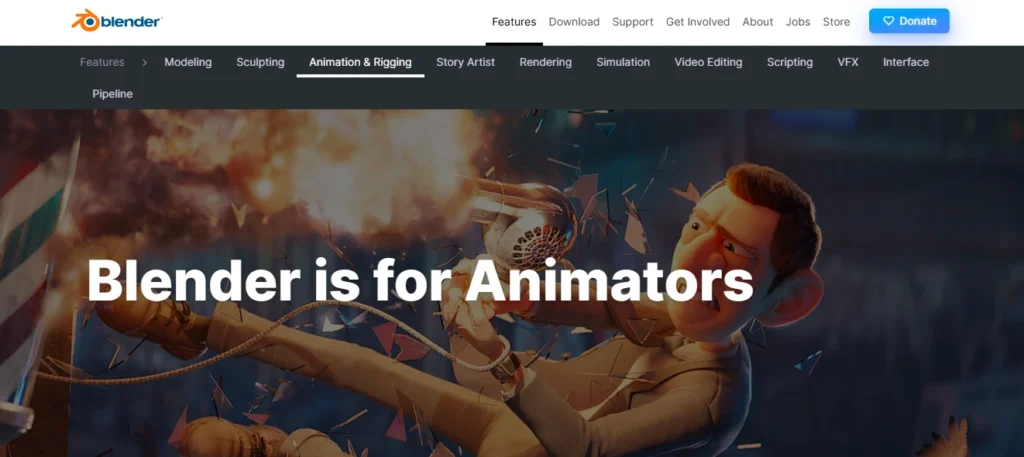
Website: https://blender.org
It is not a good free tool; it is a complete, professional-grade 3D animation package capable of rivaling industry, and it won’t cost you a rupee. Whether you fantasise about making beautiful animations, jaw-dropping 3D models, game props, or even animated features, Blender gives the power into your hands. It is packed to the gills, including modeling, sculpting, texturing, rigging, animation, rendering, video editing, and even a built-in game engine.
It has an open-source code, so a huge community of the world is continuously upgrading it, giving away free add-ons and producing tutorials that make learning fun. Whether it be Pixar-style animations or photorealistic product designs, Blender demonstrates that you do not need a Hollywood budget in order to turn the creations of your mind into reality, only a little creativity, a steady amount of patience, and this all-around toolbox.
Key Features:
- Cycles & Eevee Render Engines
- Grease Pencil Tool
- Advanced Rigging & Skinning
- VFX Capabilities
- Cross-Platform Open Source
Pros
- Free – No cost down the line, membership, or test.
- Professional Quality
- Immense Community Support, Endless free add-ons, resources, and tutorials.
- Flexible to use in animation, game design, VFX, product renderings, etc.
- Frequent Update
Cons:
- Steep Learning Curve
- Resource-Hungry Needs heavy projects on a good PC.
- Interface Complexity
Pricing: Free
Also Read: Video Editing Software
3. Toon Boom Harmony – Best for Traditional & Digital TV Animation
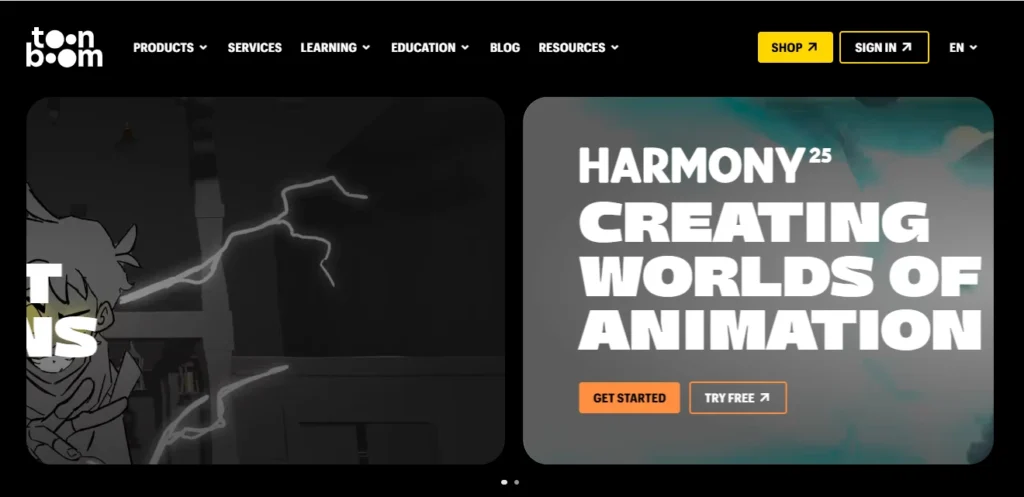
Website: www.toonboom.com
Assuming animation had an Oscar, Toon Boom Harmony would be the top recipient of the Oscar award as the best performer on a year-to-year basis. It is what drives the success of numerous television programs because even the biggest names like Disney, Cartoon Network, and Nickelodeon utilize it.
It is where the traditional hand-drawn art and high technology computer tools interact with each other, and an animator can produce expressive characters, a movement or a scene at the broadcast levelYou either adore the allure of frame-by-frame action or need the pace of rig-supported workflow, but in either case, Harmony will help you do it, and do it well, gracefully, and with style. It is not merely a software, it is the anchor of the most successful animation studios in the world.
Key Features:
- Hybrid Animation Power
- Advanced Rigging & Cut-Out Animation
- Professional Drawing & Painting Tools
- Special Effects Library
- Multi-Layer & 3D Integration
- Industry-Standard Output
Pros:
- State-of-the-art animation studios throughout the world use evidence of professional quality.
- It is suitable for both digital and classical styles of animation.
- Outstanding rigging equipment that is fast and makes exemplary animations fluid.
- Features the compositing and includes special effects without using third-party applications.
- It can support large producers to small indies and support up to any size of production.
Cons:
- The very steep learning curve takes some patience to learn.
- Premium pricing can be costly for hobbyists or small work.
- Takes a powerful computer to work out in big projects.
Pricing:
Essentials start pricing at about or under $25/month; Advanced and Premium pricing is higher, depending on features and licensing.
4. Moho Pro – Best for Character Animation
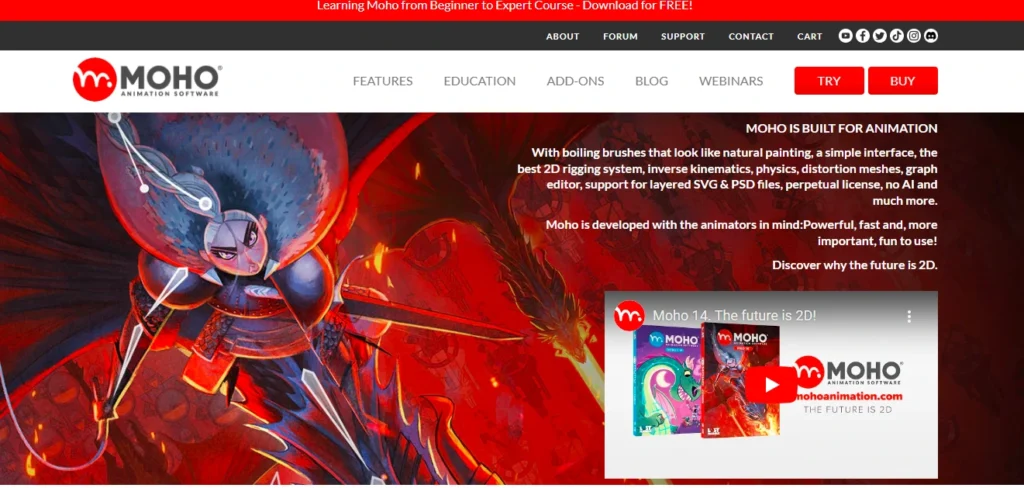
Website: https://moho.lostmarble.com
Have you ever wanted your characters to come jumping off the page (or screen with an expression and a kinesthetically realistic movement to them? If you have, then Moho Pro is like a magic wand that you would want to have. Moho Pro is used by hobbyists, indie creators alike, and even award-winning animation studios, and incorporates ease of use with industry-level capabilities, allowing you to create animations that will seem as though they came directly out of a finished animation.
It has a Smart Bones feature which helps in making complex movements, e.g., bending an arm, turning a head, or twisting the body, look very natural without the awful-looking puppet creases. And using vector-based drawing tools, you can even design within moho or bring in your artwork and rig it with pin-sharp accuracy. The software also facilitates frame-by-frame animation, layering systems, and physics simulations in order to bring your characters to life and add depth and character, as well as that certain element of life that will make viewers want to believe in your characters.
Whether it is an adorable cartoon, epic action sequence, a crazy short film, or anything, Moho Pro offers the speed, flexibility, and control that you require to bring your imagination into moving art.
Key Features:
- Smart Bones
- High-powered Rigging Tools
- Vector-based Drawing
- Physics Engine
- Frame-by-Frame Support
- 3D Camera
- Layer Compositing
Pros:
- Complex character rigging that was of professional standard.
- Minimalist software that reasons well on a majority of systems.
- An excellent combination of the tools of vectors and animation in a single location.
- Easy-breezy workflow-suitable to both 2D cut-out and classic styles.
- It is cheap when compared to other premium animation software.
Cons:
- Minor learning curve for first timers not familiar with rigging.
- Does not have as many painting and texturing tools as art-dedicated software.
- Not 3D animation friendly (2D-centric).
Pricing:
Moho Pro 14: This is a one-time fee of 399.99 (free trial as well).
5. Pencil2D – Best for Beginners
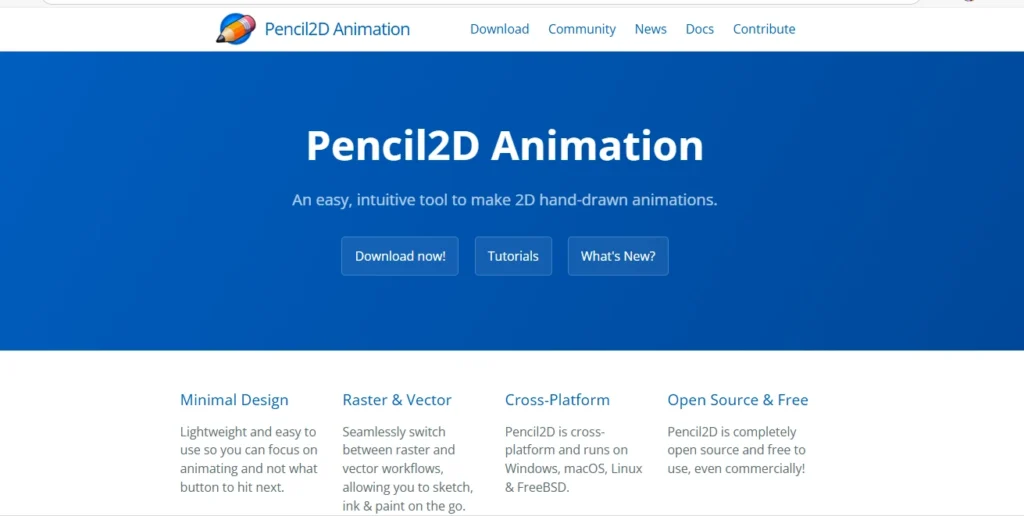
Website: https://www.pencil2d.org
Pencil2D is your new friend when you are a beginner in drawing animation, but you want to work with ease, like in your sketchbook, but without how many buttons do these things have? It is an entry-level, easy-to-use, free animation software, and is explicitly the most appropriate program to create 2D hand-drawn animations.
The switching between raster (bitmap) and vector graphics is also easy, so you can paint pixels until your heart is satisfied and draw cutesy lines in the same clean vector without those boondoggles.
Key Features:
- Intuitive interface designed for new users
- Two Drawing Modes
- Lightweight & Fast Light enough to run even on old computers.
- Onion Skinning -We were able to see numerous frames at the same time, so that the animation is easier.
- User-definable Shortcuts
Pros:
- Fully open source and free.
- It is ideal for absolute beginners.
- Lightweight, thus it is compatible even with low-spec PC.
- Versatile to have raster and vector drawings in the same file.
- Continuous news and assistance to the community.
Cons:
- Lacks some strong features that are offered by pro animation software, such as Adobe Animate.
- No in-built library of assets/templates.
- The export capabilities are limited.
Price: Free- no (additional) payments.
6. Autodesk Maya
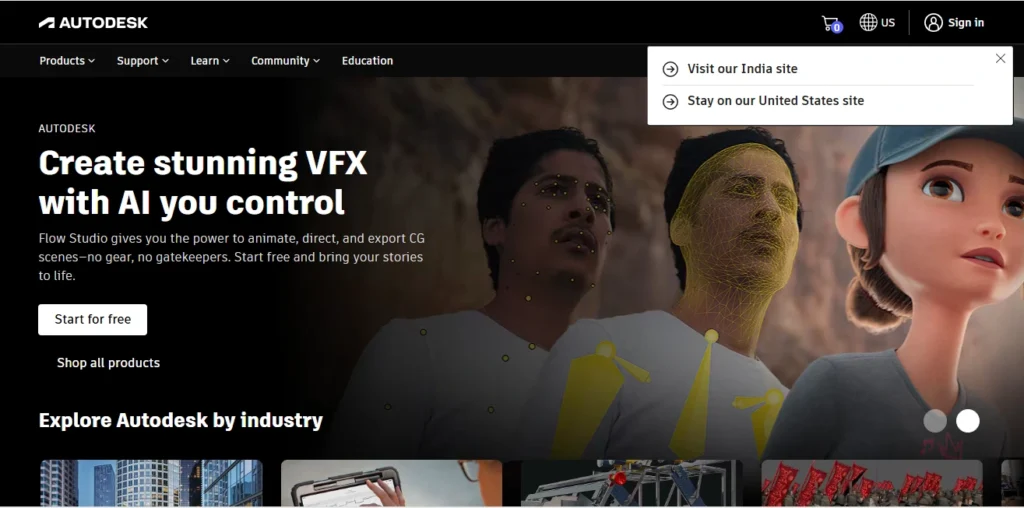
Website: https://www.autodesk.com
Autodesk Maya is an advanced 3D animation tool that is unique in its ability to provide artists with a blank canvas to be able to create, animate, and model worlds with amazing detail. Compared with many other animation software options, which specialize in either 2D or basic effects, Maya is designed to create fully realistic 3D objects and realistic movements with a high level of cinematic quality as applied in blockbuster films, video games, and television series.
Key Features:
- 3D Modeling has advanced,
- powerful rigging, keyframing, and motion capture features to make realistic animations.
- Dynamics & Effects
- Rendering Engines
- Scripting & Customization
- UV & Texture Mapping
- Virtual Reality and Game Export
- Performance Optimization
Pros:
- Film, animation, and game industry standard.
- All-in-one toolset
- Very customisable using scripts and plugins.
- Dense learning materials and communal backing.
- We are a known brand trusted by industry leaders such as Pixar, DreamWorks, and game developers.
- Arnold Professional-grade rendering.
Cons:
- Steep learning curve
- Expensive to use a professional
- Resource-intensive
- May be clumsy and bloated on small or simple projects.
Pricing: Annual: $2,010; Monthly: $170
7. Cinema 4D
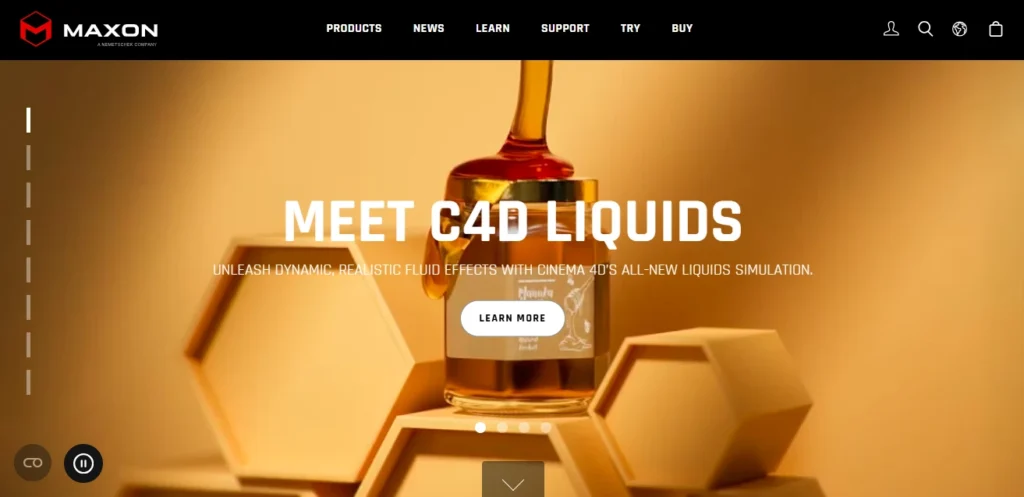
Website: www.maxon.net
Unlike most of the complex animation applications, Cinema 4D is an impressive 3D animation and motion graphics software program that is popular due to its simplicity and speed. Cinema 4D is not as overwhelming as other software is because it is intuitive enough to be used by first-time users, yet professional-level to ensure that it helps an artist create beautiful 3D paintings, animation, and visual effects, as well as design products without a significant learning curve.
The uniqueness of it is its easy-to-use interface, stability, and robust motion graphics such as MoGraph, which is prevalent in films, advertising, and broadcast design. The standard solution of creators seeking the professional results of a 3D appearance, but also an easy and elevatory experience.
Key Features:
- Intuitive User Interface
- MoGraph Module
- Easy Compatibility
- Procedural Workflows
- High-end Rendering
- Character Animation Tools
- Cross-Platform Stability
Pros:
- Simple learning curve as compared to other 3D animation packages.
- Broadcast/Advertisement standard and industry standard in motion graphics.
- Very stable, even for heavy and complex projects.
- Friendly documentation, tutorials, and excellent community support.
- Quick redshift rendering.
- Superior strength and usability for the novices, yet for the experienced.
Cons:
- High cost of licensing in comparison to other competitors.
- Few built-in sculpting tools (not powerful enough in comparison to ZBrush).
- Reduced the speed of building in some high-end features, such as fluid simulations.
- Infectious dependence on third-party plug-ins in special tasks.
- Demands usability with high-performance hardware to run smoothly with complex scenes.
Pricing: US $69.91 per month when billed yearly
8. Synfig Studio
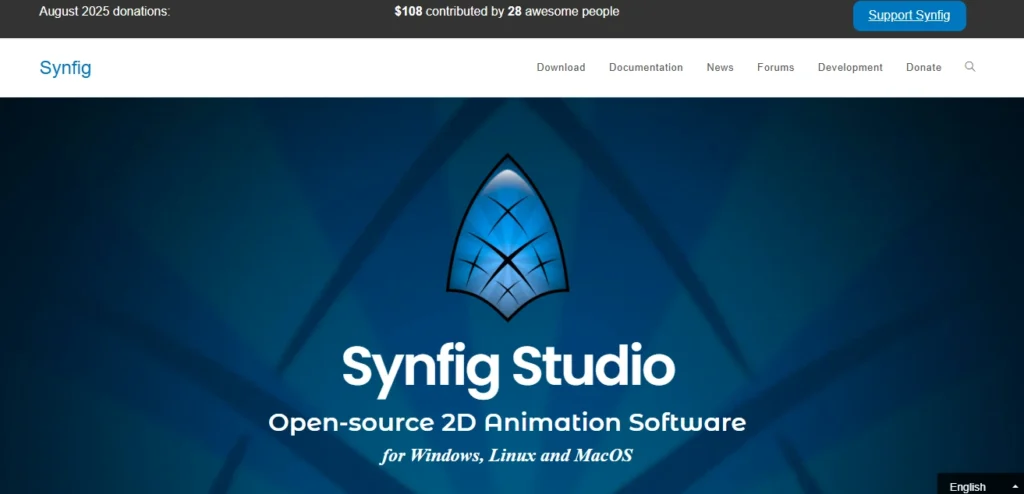
Website: www.synfig.org
Synfig Studio is a free, open-source, 2D animation package intended to enable its users to produce high-quality animation without having to endure the frames. The standout factors are that, over other animation tools, it is based on a vector workflow, meaning you can resize and manipulate artwork without sacrificing quality, it has excellent automating abilities that will allow you to achieve fluid motions and break-out animations, and it to even create complicated character rigs in fewer work steps.
In stark contrast to most entry-level apps, Synfig does provide pro level features, such as bones, gradients, and advanced layers, but at the same time, it is within reach of first time users who want to get to know what serious animation is all about without having to resort to professional level software and shell out costly bucks.
Key features:
- Vector-Based Animation
- Automatic Tweening
- Powerful Skeletal Rigging System
- Layer System
- Sound Support Sound Input and sync audio channels on your animation timeline.
- Bitmap Artwork Support
- Onion Skinning
- High Dynamic Range Imaging (HDRI)
Pros:
- Open-source
- Good community support and constant developments.
- Removes the necessity of frame-by-frame animation to work with smart tweening.
- Suits the novice and professional animators.
- Professional features at a non-professional software price.
- Inconspicuous and multifunctional.
- Very useful as a 2D character rigging program or cut-out animation.
Cons:
- Higher learning curve in comparison with tools intended for beginners.
- Does not have the smoothness and performance of a commercial-grade animation application.
- Complex projects can reduce performance.
- Very little formal documentation (Community tutorials, however, are helpful).
- Interface can be old-fashioned and less user-friendly.
- No 3D support built in, and limited to 2D animations.
Price: Synfig Studio is free, open source.
Suggested Read: Photo Editing Software
9.OpenToonz
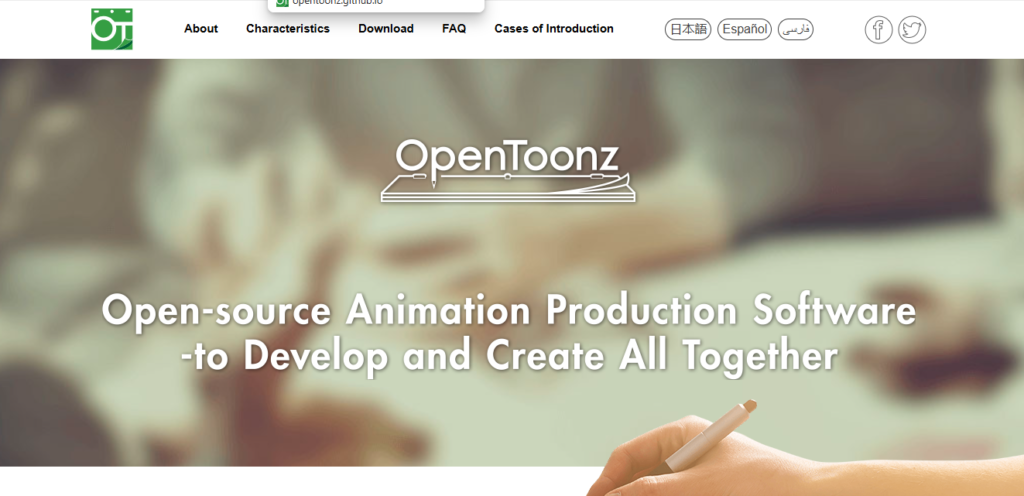
Website: http://opentoonz.github.io/e/
Another free software is OpenToonz, an open-source 2D animation program that is unique in that it was first employed by the Studio Ghibli, the authors of such legendary movies as Spirited Away. OpenToonz, unlike many other tools in animation, has the advantage of both the professional capabilities of the tool, as well as allowing the user to completely customize these features and even add their own to suit a particular style.
It works not only with the traditional hand-drawn animation (through scanning drawings), but also with digital processes, which makes it ideal for beginners mastering the fundamentals, as well as for studios producing large projects. But what is so special about OpenToonz is that those boundaries are not as rigid. Thanks to the combination of professional roots and open-source versatility, you are getting high-quality tools without the weight of their cost.
Some of the highlights of the OpenToonz
Key features:
- Open-Source & Free
- Hand-Drawn and Digital Animation Support
- GTS Scanning Tool
- Effect SDK (Effect Development Kit)
- Vector / Raster Support
- Intense FX Library
- Automatic In-betweening
- Plugins & Scripting compatible
Pros:
- Free and open-source, 100 percent accessible to all.
- Industry-level animation software was utilized.
- Accommodates the traditional and digital forms of art.
- A big community of developers is continuously developing the software.
- Windows & macOS.
- Highly scriptable / effects-oriented.
- Wonderful both as a student fare, and as an introduction and professional manual.
Cons:
- Steep learning curve as opposed to easy-on-the-entry animation applications.
- The user interface is old-fashioned and confusing.
- Few official tutorials; it is heavily dependent on user guides.
- The bugs and stability problems every now and then concern mostly old systems.
- Not quite as natural as motion graphics as in Adobe Animate or Toon Boom Harmony.
10. Krita
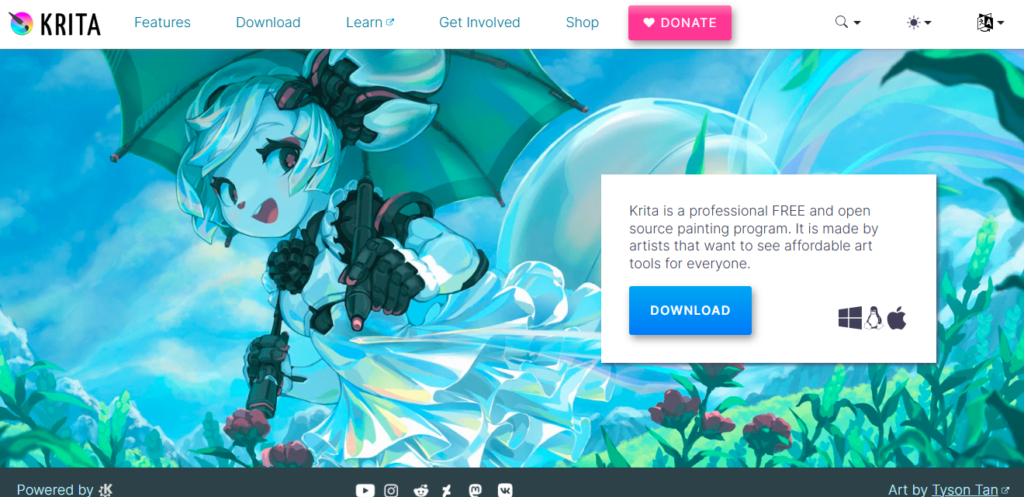
Website: http://krita.org
frame-by-frame animations, and it is made specially to accommodate artists. Where many other animation tools are mostly motion graphics-based or 3D-based, Krita excels at providing you with a realistic drawing experience, like on paper or even painting on canvas. It also has professional-quality brushes, textures, layers, and coloring tools, but is simple enough to allow beginners to start experimenting.
This is brand Krita: it is engineer-designed, artist-built because it is what artists and creators asked and needed, and that makes the features not only useful but creative and intuitive, as it can go directly to the needs and interests of creators of every kind, including graphic artists, comic artists, animators whose creative output can be quite expressive and even controversial, and who want to be able to produce, with no monetary outlay whatsoever.
Key features:
- Massive Brush Engine + 100+ preloaded brushes
- Enhanced Layer Techniques
- Stabilization for Smooth Drawing
- Animation Support
- Open-Source & Free.
- HDR and PSD Support
- Customizable UI and Shortcuts
- Community-Generated Plugins
Pros:
- Easy-to-learn interface that newcomers will be able to get used to easily.
- Tablet PC and stylus use pressure sensitivity.
- Professional, free, and open-source applications.
- Good concept art, good illustration, and comic work.
- Community-driven daily updates
- cross-platform (Windows, macOS, Linux).
Cons:
- It is resource-intensive on low-end machines.
- Animation tools are simpler as compared to specialized ones.
- Its text editing applications are limited, thus, not making it the best tool in the project where there is a lot of graphic design work to be done.
- It does not contain all of the photo-editing capabilities of Photoshop.
Comparison Table
| Software | Best For | Pros | Cons | Pricing |
|---|---|---|---|---|
| Adobe Animate | Professional 2D Animations | Versatile, scalable graphics, Adobe integration, creative freedom | Subscription-based, resource-heavy, not strong in 3D | $22.99/month |
| Blender | Free 3D Animation | Free, professional quality, huge community, versatile | Steep learning curve, resource-hungry, complex interface | Free |
| Toon Boom Harmony | Traditional & Digital TV Animation | Industry standard, supports both 2D & digital, studio-grade | Expensive, steep learning curve, needs a strong PC | From ~$25/month (higher tiers costlier) |
| Moho Pro | Character Animation | Strong character rigging, easy workflow, affordable one-time license | Limited 3D, fewer painting tools, learning curve for rigging | $399.99 one-time |
| Pencil2D | Beginners | Free, easy, runs on low-spec PCs, beginner-friendly | Limited features, no asset library, basic export options | Free |
| Autodesk Maya | Professional 3D Animation | Industry standard, powerful, customizable, trusted by studios | Very expensive, steep learning curve, resource-heavy | $2,010/year or $170/month |
| Cinema 4D | Motion Graphics & 3D Design | Easy to learn, stable, strong motion graphics, fast rendering | Expensive, fewer sculpting tools, heavy reliance on plugins | $69.91/month (yearly billing) |
| Synfig Studio | Free Vector-Based 2D Animation | Free, pro-level features, removes the frame-by-frame need | Learning curve, weaker performance, outdated interface | Free |
| OpenToonz | Open-Source 2D Animation | Free, used by Studio Ghibli, customizable, pro-level features | Old interface, bugs, steep learning curve, few tutorials | Free |
| Krita | Digital Artists & 2D Animators | Free, artist-focused, intuitive, community-driven, cross-platform | Basic animation tools, limited text editing, resource-heavy on weak PCs | Free |
Conclusion
Selecting the right animation software could only come down to requirements, abilities, and objectives. No matter what you are, an amateur trying your hand at the creation of 2D design, a professional designer, creating a complex 3D world, or a business making compelling explainer videos, there is a tool that suits you.
Professional tools, such as Adobe Animate, Toon Boom, and Blender, have high-end features, and user-friendly tools such as Pencil2D or Animaker allow anyone to get into animation. There can never be a wrong decision when it comes to meaning, features, ease of use, price, and your vision of what you want to make, especially since by the end of the day, you are the artist with great thoughts who is making this come through animation with the help of the software as the brush through which it is realized.
FAQs
Which is the best animation software?
Good beginners include freePencil2D and Synfig Studio.
What software is Disney animation made with?
Disney has used Toon Boom Harmony and Maya software to carry out 2D and 3D animation, respectively.
Am I free to do animation without drawing skills?
Yes! Blender and Moho Pro are tools enabling you to use pre-made assets, rigs, and motion graphics.
What is the good free animation software?
Blender (3D) and Pencil2D (2D).